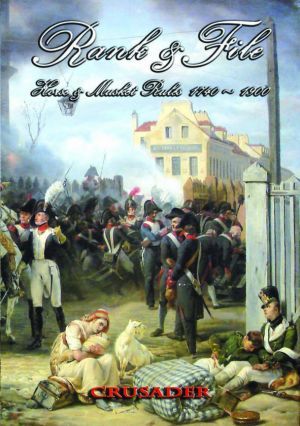|
|
|||||||||||||||||||||||
 |
|
The Rules Directory only works if you help. Write a review. Get the review template here. |
|
TITLE: Rank and File: Horse and Musket Rules 1740-1900 AUTHOR: Mark Sims PUBLISHER: Crusader Publishing PUBLICATION DATE: 2009 WEB SITE/SUPPORT FORUM: Crusader’s website is here. There is a Yahoo group to support the rules here. PRICE (with date):
REVIEWED BY: John Acar PERIOD COVERED: 1740-1900 THE BOOK: The copy I am reviewing is a 63 page PDF. There are color photographs of miniatures and miniature games in action for inspiration. The book is divided into 12 chapters and 3 appendices. The PDF is printer friendly (White paper. Black text.) SCOPE: This is a generic horse and musket era rules set for land warfare. ARMY SIZE: Number of figures on a stand is unimportant. This game is geared for Division or Corps sized battles. BASE UNIT: The smallest unit in the game can either be a regiment or a battalion depending on the scale used. GAME SCALES:
BASING SIZES: The game used the WAB/Foundry basing system:
TURN SEQUENCE:
GAME MECHANICS: Movement in Rank and File is fairly simple. Units are assigned a movement rate based on the formation they are in. Units move straight ahead or oblique at no cost. They wheel or perform a facing change to turn. There are rules for charging, evading charges and march moves. Possible formations are column of march, assault column, square, line, skirmish order or reinforced line depending on the unit and time period the players are playing. Artillery may be limbered or unlimbered. All pretty standard stuff. All regular movement rates are fixed rates. All evade moves are a random amount, either 2D6 or 3D6. All tasks are resolved by rolling 1 or more D6. Shooting and melee are resolved by throwing 1D6 per stand and counting the number of hits. A hit occurs for each die that is equal to or greater than the modified target number. The base target number is 4+ with the usual modifiers for cover, formation, disorder and such. For every 4 hits, a stand is eliminated. Units may only voluntarily melee if they charge during the charge phase. Casualties are calculated in the same manner as with firing. The winner of the melee is/are the unit(s) that scored more hits than the enemy. If an officer is attached to the meleeing unit, he adds one to the total number of hits inflicted for resolution purposes only. Morale checks are resolved by throwing a single die against a target number based on the checking unit's morale grade. These grades are Green, Regular and Veteran. There are, of course, situational modifiers for casualties flanking and the like. If the unit passes, nothing happens. If the unit fails, its morale status is reduced by one level. There are three levels of morale, Good, Unsteady and Routed. Rally checks are resolved in the same way. If the rally check is passed, the unit increases its morale level by one. If it fails, nothing happens. A unit that has taken 50% or more casualties may not rally. They also always fail a morale check if required to take one. The game is won or lost when one army reaches its break point. Each unit eliminated takes 2 points away from the army break point. When the army morale total of one side is reduced to 50% or less, the battle is over. There are all sorts of special rules for various aspects for the periods covered. Each period has rules for which formations and unit types can be used and what they represent. There are 3 free supplements for Rank and File. Supplement One has rules for waver tests (morale tests for being charged), blown (tired) horses and uncontrolled advances. Supplement Two contains a points system for the game. Supplement Three has rules for rocket batteries, lancers and grand batteries. All supplements can be downloaded from the publisher’s web site. ARMY LISTS/SCENARIOS: At the end are some sample army lists but there are no formal army lists or scenarios that come with Rank and File. The game is simple enough to be able to adapt existing scenario books. REVIEWER’S COMMENTS: The game is clearly written and laid out. The mechanics are very straightforward. The designer of the game did not make any assumptions that lead to fiddly rules and special cases. This game is a nice blend of old school and modern rules. There are examples and diagrams in the book to help explain how the rules work. There is also a game example toward the back of the book that takes you through several turns. Rank and File would make a very good convention or club game. It is easy enough that a beginner could pick it up quickly but has enough detail for more veteran gamers. PLAYER’S COMMENTS: I have not played the rules but will update this review when I do. |
|
[Home] [15mm World] [Reviews Home] [How To] [Beginners Guide] [Gamer's World] [Spanner & The Yank] [Points of View] [The Annex] [Links] [Say Howdy] [Corporate Schill] [Rules Directory] |
 |
